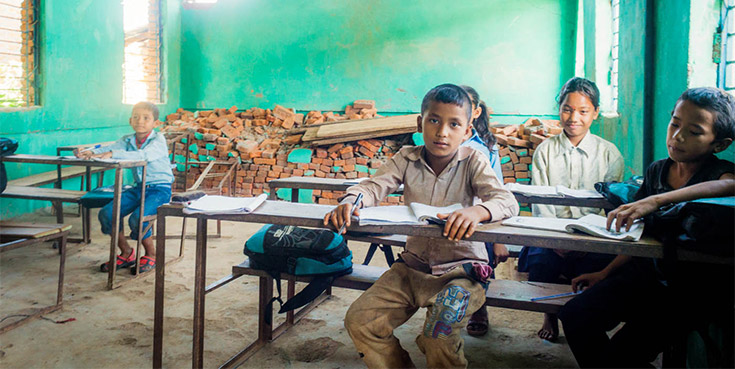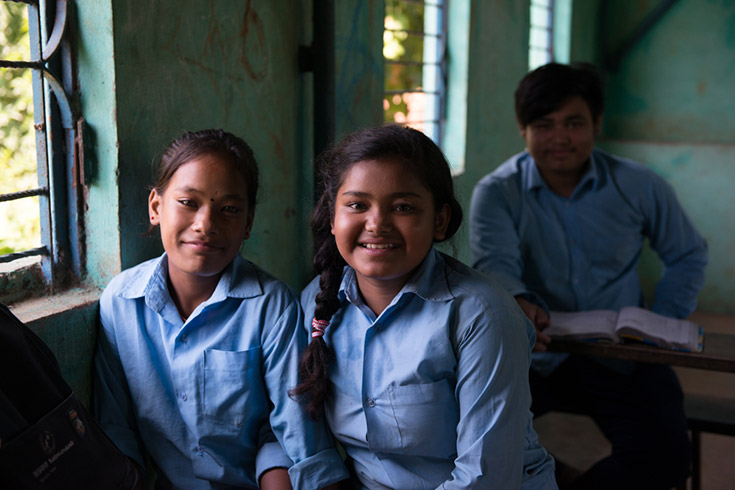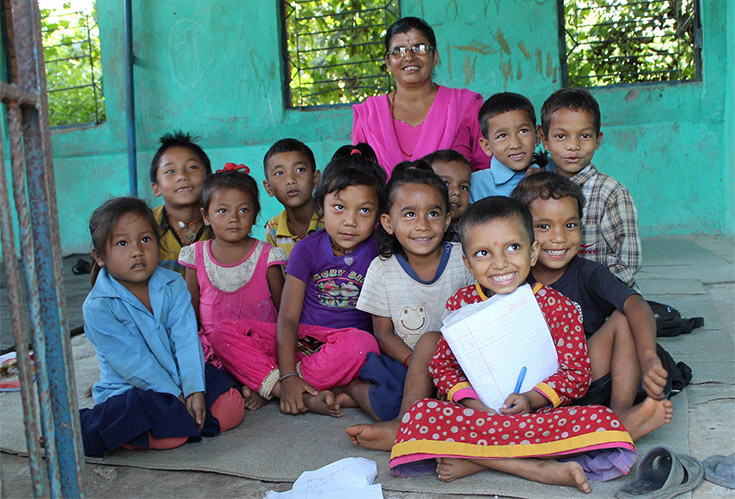Music and sports help children recover from Nepal quake
CRJ’s Pakistan Correspondent and Blog Editor Luavut Zahid commissioned this piece after a trip to Nepal where she observed first hand damage caused by this year’s earthquake. The author, Sana Jamal, looks at an important aspect of rehabilitation after an earthquake – the children. The piece not only helps shed light on the aftermath of the earthquake and its impact on children, but helps point out important techniques that other countries can use to help those who have suffered trauma.

Children at Shree Bhawani Lower Secondary School in Dhaitar village, Nepal (photo: Lifei Feng)
Kathmandu, Nepal: The crumbled buildings and big cracks in the walls of most of the classrooms make it hard for the students to forget the tragic and devastating earthquake of April 2015. To overcome the traumatic conditions of the students, schoolteachers in Nepal are focusing less on books and instead promoting sports and musical activities to help students start anew.
“When the classes resumed in September, (four months later) the children were too afraid to sit inside the class room and little sounds such as the noise of a nearby tractor in the fields would scare them, and they thought it was another earthquake,” says Rukmani Nepal, who teaches students in eighth grade in Shree Bhawani Lower Secondary School in Dhaitar village, about two hours’ drive along a bumpy road from Kathmandu, Nepal’s capital.
“The fear is high even within us, so you can easily imagine the state of children,” tells Rukmani, adding that they decided to hold the classes in the open air at first.

Nepali schoolchildren playing sports (photo: Sana Jamal)
Teachers in the area know that it isn’t the buildings that need work, but the children that require tender, love and care. The catastrophe that killed more than 9,000 people, and destroyed hundreds of houses throughout the country, has left deep scars.
“Instead of following the school curriculum, we have now introduced music and sports lessons such as songs, dance and games like ludo (snake and ladders), carom, running and skipping so that the kids would involve themselves in games and learn to forget their fears,” Rukmani told me.
“Playing games and singing songs bring smiles back on the faces of terrified children who were otherwise too scared to come to school.”

Photo by Susan Hale Thomas
Interestingly, activities like sports and music are helping attract more students in a small public school which has about 45 registered students and eight teachers. Many other Nepali schools are now adopting new ways of engaging students in learning by focusing on games and music.
Dhakal Prasad Dmital is a teacher in a nearby village in Patlekhel.
“At least three of our seven school buildings were damaged by the earthquake” he says. But the major problem was the psychological impact on kids.
“As the children are frightened and severely disturbed by the earthquake, our school (Shree Hanuman Higher Secondary School) is focusing on activities like games and songs to make sure kids can slowly resume their studies and their lives,” Dmital said.
According to UNICEF estimates, over 24,000 school buildings were damaged or destroyed in the Nepal earthquake.
Rishi Kanta Ghimire, Program Officer at Nepal’s Office of the District Development Committee said the government has provided at least 100,000 Nepali Rupees (USD 957) per school for the rebuilding process. “We immediately send out tents, food, blankets, and medicines too,” he added.
Ghimire says that the Nepal government has coordinated with international NGOs to provide psychological counseling to traumatized children and adults.
Teachers like Dmital and Rukmani feel the school needs more sports and music staff as well as equipment to help invigorate the minds of the students and help them believe in the future.
Anisha, a 15 year old student in the eighth grade, is a quiet young girl, but is very certain about her future goals. “I want to be a teacher so I can save lives,” says Anisha. The tragic 2015 earthquake altered Anisha’s dream of becoming a doctor. However, she and many other children in Nepal continue to show great resilience and faith in a brighter future.

Anisha, 15, wth her friends in Shree Bhawani Lower Secondary School in Dhaitar village in Nepal (Photo by Susan Hale Thomas)
After the earthquake, the Nepal Academy of Music and Drama also organised events with celebrities, singers, artists and comedians as part of facilitating recovery from psychological impact of earthquake.
What can Nepal teach South Asia?
Nepal’s approach to dealing with children that have suffered through great trauma can set an example for other countries.
After the recent 7.5 magnitude hit earthquake hit parts of Afghanistan and Pakistan, many are wondering what lessons can be learned from Nepal. At present, some sources suggest that over 155 schools have been damaged in Khyber Pakhtunkhwa alone.
Pakistan specifically has not just suffered natural calamities, children here also live in the shadows of terrorism. The result is Post Traumatic Stress Disorder (PTSD), which is a mental anxiety condition that can be triggered after experiencing or witnessing a terrifying event such as terror attacks, natural disasters and assaults, according to Raheela Kanwal, a child psychologist at the National Child Protection Center Islamabad.

Photo by Sana Jamal
“Kids who have been exposed to armed conflict or disaster are at high risk of mental-health problems,” she told me. Kanwal’s experience comes from her work with child refugees and internally displaced children.
“Expressive arts therapies such as music, arts and games can be effective strategies for trauma recovery,” she suggested, adding that music and play activities also proved to be helpful in dealing with internally displaced kids in Pakistan.
Pakistan, and all of South Asia, should think of taking a page out of Nepal’s books and focus on not just rebuilding schools, but also rebuilding the minds of the children that have suffered.
By Sana Jamal is a journalist based in Islamabad, Pakistan.
Luavut Zahid, 04/11/2015